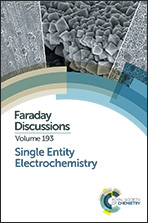In situ video-STM studies of the mechanisms and dynamics of electrochemical bismuth nanostructure formation on Au†
Abstract
The microscopic mechanisms of Bi electrodeposition on Au(111) and Au(100) electrodes in the overpotential regime were studied by in situ scanning tunneling microscopy with high spatial and temporal resolution. Atomic resolution images of the needle-like Bi(110) deposits formed on Au(111) reveal the central influence of covalent Bi–Bi bonds on the deposit morphology. In the straight steps along the needle edges the Bi atoms are interlinked by these bonds, whereas at the needle tip and at kinks along the needle edges dangling bonds exist, explaining the rapid structural fluctuations at these sites. For ultrathin Bi deposits on Au(100) a more open atomic arrangement was found within the surface plane, which was tentatively assigned to an epitaxially stabilised Bi(111) film. Furthermore, well-defined nanowires, consisting of zigzag chains of Bi surface atoms, were observed on this surface.
- This article is part of the themed collection: Single Entity Electrochemistry

 Please wait while we load your content...
Please wait while we load your content...